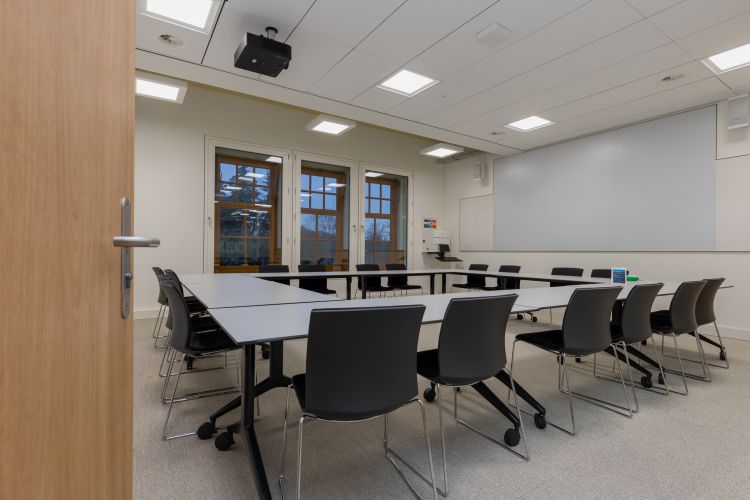
Diverse school children students build robotic cars using computers and coding. Happy multiethnic kids learning programming robot vehicles sitting at table at STEM education science engineering class.
Flexible learning spaces represent a departure from the traditional classroom model, which often prioritizes a one-size-fits-all approach to education. By contrast, flexible learning spaces are designed to be dynamic, adaptable, and responsive to individual student’s unique needs and preferences.
These spaces promote student engagement, collaboration, and critical thinking by providing an environment that encourages exploration, experimentation, and active learning. By offering a variety of learning zones, furniture, and technological resources, flexible learning spaces empower students to take charge of their own learning experiences and develop the skills necessary for success in today’s interconnected world.
Read on to learn about transforming your classroom into a flexible learning space in six easy steps.
Step 1: Identify The Needs Of Your Learners
The foundation of any successful flexible learning space is a deep understanding of the needs of your learners. To gain this understanding, begin by conducting a thorough assessment of your students’ learning styles, strengths, challenges, and preferences.
Consider factors such as age, developmental level, subject matter, and any special needs within the classroom. This assessment may include surveys, observations, or conversations with students, parents, and colleagues.
Reflect on how your learning space can foster the development of critical skills, such as creativity, problem-solving, communication, and collaboration, to prepare students for success in an increasingly interconnected world.
Step 2: Choose Flexible Furniture
Selecting furniture that can be easily reconfigured is vital to creating a flexible learning space. Consider desks or tables that can be arranged in various configurations, such as circles, clusters, or rows, to support different learning activities and group sizes.
Chairs that are lightweight and easily movable, such as stackable or wheeled options, allow for quick and effortless transitions between activities. Additionally, incorporating storage solutions that can be adapted to different needs, such as modular shelving or rolling carts, will ensure that materials and resources are readily accessible and organized.
When choosing furniture, also consider the importance of ergonomics and student comfort. Look for options that support healthy posture and can accommodate students of various sizes and abilities. When buying furniture for your classroom, you can check out the school supply company Grocorp or other reputable providers to ensure great quality.
Step 3: Establish Learning Zones
The next step is to divide your space into distinct learning zones that accommodate a variety of learning activities and interactions. These zones can include areas for individual work, group collaboration, quiet reflection, technology integration, and presentation or demonstration.
To optimize the effectiveness of your learning zones, consider incorporating visual cues and signage to help students navigate the space and understand the purpose of each area.
Additionally, ensure that the zones are flexible and adaptable to accommodate the ever-changing needs of your students and curriculum. This might involve using movable walls, partitions, or furniture that can be easily rearranged to create new configurations and support a range of activities.
 Step 4: Integrate Technology
Step 4: Integrate Technology
Technology plays a crucial role in modern education, and a flexible learning space should seamlessly incorporate technology to support diverse learning experiences.
Ensure that students have access to devices such as tablets, laptops, or desktop computers, which can facilitate research, collaboration, and the creation of digital content. Additionally, consider investing in interactive whiteboards, digital projectors, and other educational technologies that can enhance learning and encourage active engagement with the material.
Beyond providing access to technology, it is essential to consider the infrastructure and support necessary to maintain and effectively utilize these resources. This includes providing adequate charging stations and outlets to keep devices powered throughout the day, as well as ensuring reliable internet connectivity and access to relevant software and platforms.
Step 5: Encourage Collaboration And Movement
A well-designed flexible learning space should encourage students to move, interact, and collaborate. Providing ample opportunities for movement, such as standing desks, balance ball chairs, or designated areas for stretching and movement breaks, can improve focus, engagement, and overall well-being.
Encourage collaboration by creating spaces for group work and allowing students to reconfigure the room as needed to facilitate different collaborative activities, such as brainstorming sessions, project planning, or peer feedback.
Additionally, incorporating visual displays, such as whiteboards or bulletin boards, can promote collaboration and communication by providing spaces for students to share ideas, document their thinking, and showcase their work.
By fostering a learning environment that supports movement and collaboration, you empower students to actively participate in their learning and develop essential skills for success in today’s interconnected world.
Step 6: Optimize Lighting And Acoustics
The quality of lighting and acoustics in a learning space can significantly impact student engagement, focus, and well-being. Ensure your space has a combination of natural and artificial light sources to create a comfortable and visually appealing environment.
Consider incorporating adjustable lighting to accommodate various activities and moods, such as dimmable fixtures or lamps that can be moved throughout the space. Use sound-absorbing materials, such as rugs, drapes, or acoustic panels, to improve the room’s acoustics, minimize noise distractions, and create a comfortable atmosphere for learning.
Additionally, consider the arrangement of furniture and learning zones in relation to the lighting and acoustics of your space. For example, place quiet reflection zones in areas with softer lighting and minimal noise, while collaborative areas might benefit from brighter lighting and more open spaces.
Conclusion
Designing a flexible learning space is a multifaceted process that requires careful consideration of learner needs, the creation of distinct learning zones, the selection of adaptable furniture, the integration of technology, and the promotion of collaboration and movement.
By optimizing lighting and acoustics and involving students in the design process, educators can create an environment that supports diverse learning experiences and accommodates a wide range of learning styles.
As schools and educators continue to adapt to the changing landscape of education, flexible learning spaces will play a crucial role in fostering student-centered learning and promoting academic success.




